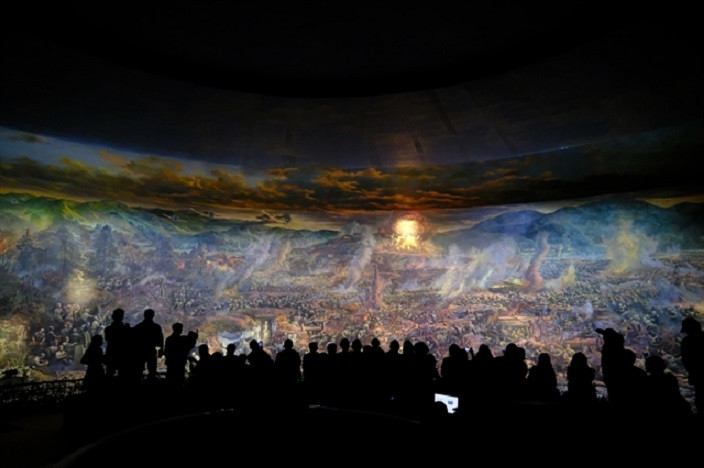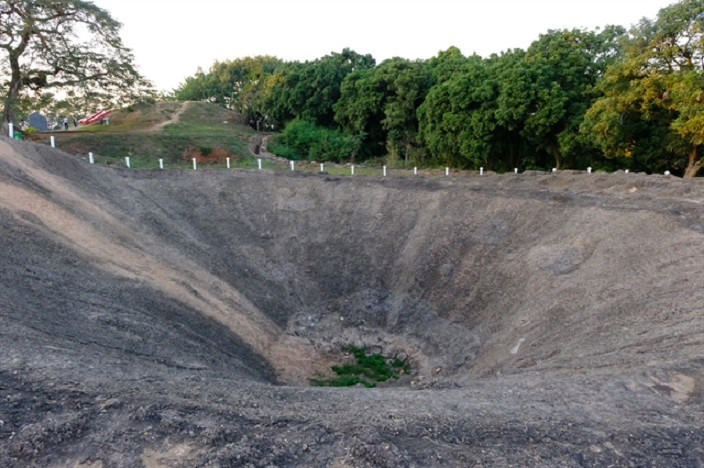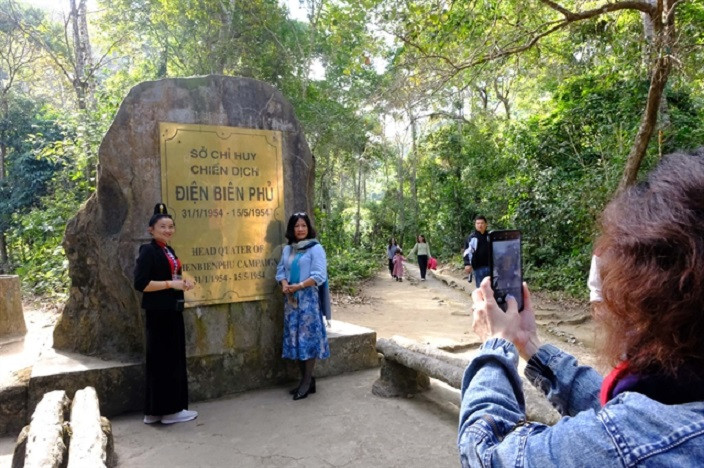Điện Biên Phủ Victory Museum, A1 Hill relics, and Mường Phăng, where the Command Headquarters of the Việt Nam People's Army was located during the Battle of Điện Biên Phủ, and where General Giáp left numerous marks on the land, are notable places for visitors to witness the stories behind the famous battle.
Điện Biên Phủ Victory Museum

The museum, located on Võ Nguyên Giáp Street in Điện Biên Phủ City, houses nearly 1,000 documents, artefacts, photographs and maps associated with Việt Nam’s historic victory.
The museum is a contemporary architectural structure whose external design is modelled after the Vietnamese foot soldier's bamboo wicker hat. They wore the hat throughout the nine-year resistance against the French in the first Indochina war, and up until the campaign was victorious.
The centrepiece of the museum is a massive panoramic painting that shows the battlefield of Điện Biên Phủ at different angles from late 1953 to May 7, 1954.
It is one of the largest war-themed oil paintings in the world at 132 metres long, 20.5 metres high, and 42 metres in diameter, making an incredible circular oil on canvas.
The artwork, which depicts 4,500 characters, shows the army as a whole marching into battle, the initial fighting at Him Lam Hill, the battle on Hill A1, and the eventual victory day.
From November 2019 until May 2022, about 200 artists, architects, musicians, and technicians worked on it. Visitors can fully immerse themselves in the historical mood of the heroic victory when looking at the work.
Hill A1

Mường Thanh Ward in Điện Biên Phủ City is where Hill A1 is situated. Hill A1 held a crucial strategic location during the campaign, serving as a vital link point that safeguarded the central subdivision and directly protected Gen Christian de Castries's bunker.
With thick concrete on the roof and robust brick walls on all four sides, a tunnel is constructed out of incredibly durable materials. There are still visible vestiges of the crater on Hill A1, which was formed by 960 kilograms of explosives detonated by the Vietnamese attacking force.
VN Command Headquarters in Mường Phăng

The Điện Biên Phủ Campaign Command Headquarters is located in Mường Phăng, hidden under the canopy of ancient forests, at the foot of Pu Don mountain.
In the headquarters, Gen Võ Nguyên Giáp, commander-in-chief of the Vietnam People's Army, issued decisive instructions and attack orders, culminating in the order for a general attack across the entire battle front on the afternoon of May 7, 1954, achieving a victory that stunned the world.
The Command Headquarters were surrounded front and back, with trenches and camps, ensuring absolute secrecy and safety. This area still preserves relics of historical value, such as the living and working shack of Gen Giáp, Deputy Chief Gen Hoàng Văn Thái, and Head of Communications Division Hoàng Đạo Thúy.
Tourist favourite
Tourists and tour operators praise the historical potential of travel in Điện Biên. What excites visitors more than anything else is listening to tour guides telling stories associated with each point of the historical destinations. Visitors feel like they can live in the story of the difficult but heroic years of the past.
“The historical location of Điện Biên Phủ left me incredibly astonished. I was deeply touched by the stories told by tour guides,” said Chu Văn Quyền, CEO of Minh Huy Travel.
“It is essential for me and other tour operators to create a tour that takes visitors to this location and recounts the tales of that valiant era.”
Vừ A Bằng, vice chairman of the Điện Biên People's Committee [provincial government], highlighted that Điện Biên Province has numerous resources and potential for the development of tourism.
Trần Thị Huyền Thanh, CEO of Wild Lotus Travel, said: “Since I started operating inbound tours in the 1990s, Điện Biên has become renowned for foreign tourists, especially former settlers, and war veterans in Indochina.”
Over 100,000 people visited the heritage site in the first half of April alone, including foreign tourists. That number continues to increase in the days ahead as the main celebrations for the 70th anniversary of the historic victory are about to take place.
Nguyễn Minh Phú, director of Điện Biên’s Department of Culture, Sports and Tourism, told Việt Nam News: “Historical-spiritual tourism is one of the three central pillars in the tourism sector that the provincial authorities have persistently upheld.”
To ensure the development of historical tourism, Điện Biên is strengthening investment cooperation in infrastructure development and creating regional connections with neighbouring provinces. The province’s road transport system connecting to other destinations in the region has also been invested in and expanded.
The Heritage Committee of Điện Biên Phủ has also improved the introduction, and promotion of information on records, artefacts, and tourism destinations, especially on digital platforms, following modern trends in digital integration.
Đặng Minh Phương, deputy director of the Điện Biên Tourism Promotion Information Centre, added: "Through the tourist information points in each destination, tourists are given QR codes that allow easy access to information about the various historical destinations and the Điện Biên Phủ Victory." VNS